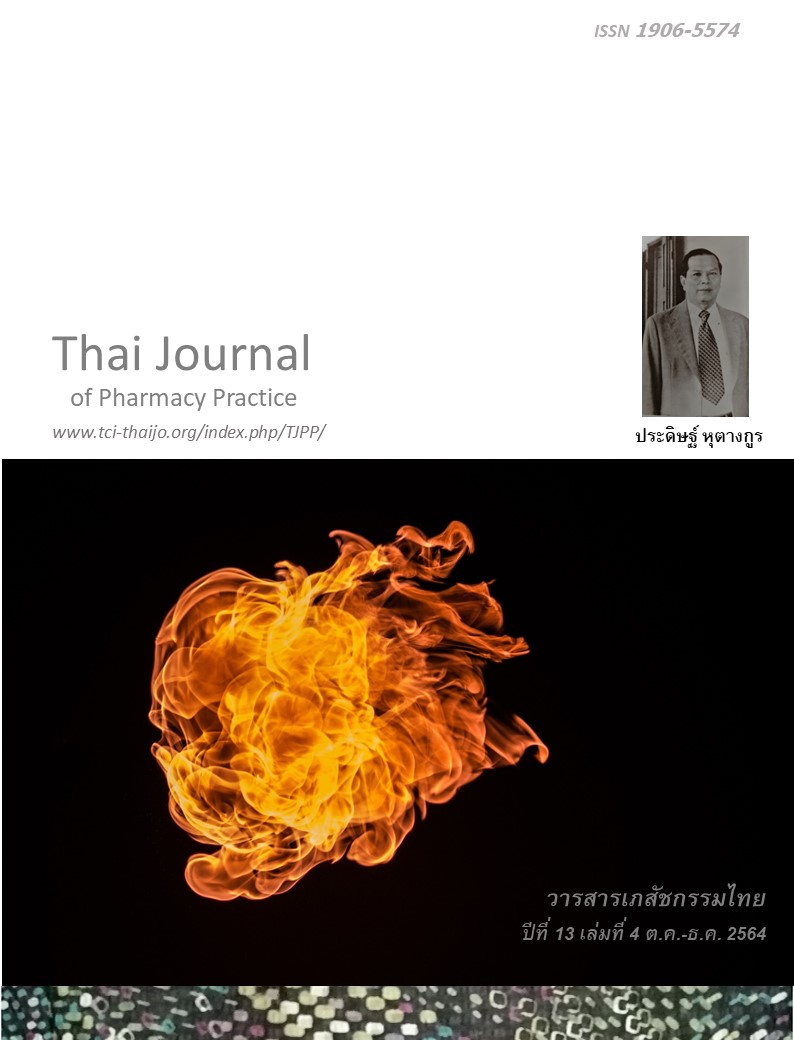ปัจจัยที่มีผลต่อความร่วมมือในการใช้ยาที่รายงานด้วยตนเองของผู้ป่วยนอกโรคซึมเศร้า
Main Article Content
บทคัดย่อ
วัตถุประสงค์: ศึกษาความร่วมมือในการใช้ยาในผู้ป่วยนอกโรคซึมเศร้า และเปรียบเทียบความร่วมมือในการใช้ยาในผู้ป่วยที่มีลักษณะต่าง ๆ ในด้านระดับการศึกษา สิทธิการรักษา การจัดเตรียมยา จำนวนรายการยา อาการไม่พึงประสงค์ และทัศนคตืต่อการควบคุมโรค วิธีการ: การศึกษาแบบภาคตัดขวางในผู้ป่วยนอกจำนวน 138 คน ที่รักษาและรับยาในโรงพยาบาลศรีธัญญาระหว่างเดือนพฤษภาคมถึงเดือนกรกฎาคม พ.ศ. 2561 เก็บข้อมูลโดยใช้แบบสอบถามพฤติกรรมการใช้ยา MTB-Thai (medication taking behavior measure for Thai patients) และแบบวัดพฤติกรรมการใช้ยา MA-VAS (medication adherence visual analog scale) ผลการวิจัย: แบบสอบถาม MTB-Thai มีคะแนนเต็มในแต่ละมิติคือ 4 ค่าเฉลี่ยมิติการลืมใช้ยา/ลืมใช้ยาโดยไม่ตั้งใจ คือ 3.32±0.75 มิติการหยุดใช้ยา/ปรับขนาดยาเอง/ลืมใช้ยาโดยตั้งใจ คือ 3.73±0.52 ส่วน MA-VAS มีคะแนนเต็มคือ 100 มีคะแนนเฉลี่ย 87.38±1.19 การศึกษาไม่พบปัจจัยที่มีผลต่อคะแนน MTB-Thai แต่ผู้ที่รายงานว่าได้รับผลข้างเคียงจากการใช้ยามีคะแนน MA-VAS ต่ำกว่าผู้ไม่ได้รับผลข้างเคียงอย่างมีนัยสำคัญทางสถิติ สรุป: อาการไม่พึงประสงค์จากยามีผลกระทบต่อคะแนนความร่วมมือในการใช้ยาของผู้ป่วยโรคซึมเศร้าอย่างมีนัยสำคัญ
Article Details
ผลการวิจัยและความคิดเห็นที่ปรากฏในบทความถือเป็นความคิดเห็นและอยู่ในความรับผิดชอบของผู้นิพนธ์ มิใช่ความเห็นหรือความรับผิดชอบของกองบรรณาธิการ หรือคณะเภสัชศาสตร์ มหาวิทยาลัยสงขลานครินทร์ ทั้งนี้ไม่รวมความผิดพลาดอันเกิดจากการพิมพ์ บทความที่ได้รับการเผยแพร่โดยวารสารเภสัชกรรมไทยถือเป็นสิทธิ์ของวารสารฯ
เอกสารอ้างอิง
World Health Organization. Depression and other common mental disorders: Global health estimates [online] 2017. [cited Oct 13, 2019]. Available from: www.who.int/mental_health/management/depression/prevalence_global_health_estimates/en/
Kittirattanapaiboon P, Tantirangsee N, Chutha W, Tanaree A, Kwansanit P, Assanangkornchai S, et al. Prevalence of mental disorders and mental health problems: Thai national mental health survey 2013. Nonthaburi: Beyond Publishing; 2016.
Department of Mental Health. Report on number of patients receiving psychiatric cares in the national level in budget year 2018 [online] 2018. [cited Oct 13, 2019]. Available from: dmh.go.th/report/datacen ter/hdc/reds.asp.
Keller MB, Hirschfeld RM, Demyttenaere K, Baldwin DS. Optimizing outcomes in depression: Focus on antidepressant compliance. Int Clin Psychopharma col 2002; 17: 265-71.
Choorat N. The study of causes and ways to prevent a recurrence of schizophrenic patients in the community of Pi-leng district health care promoting hospitals which experiencing unrest situation in the southern provinces of Thailand. The Princess of Naradhiwas University Journal of Humanities and Social Sciences 2016; 3: 24-36.
Hatch A, Docherty JP, Carpenter D, et al. Expert consensus survey on medication adherence in psychiatric patients and use of a digital medicine system. J Clin Psychiatry 2017; 78: 803-12.
Lindstrom E, Lewander T, Malm U, et al. Patient-rated versus clinician-rated side effects of drug treatment in schizophrenia. Clinical validation of a self-rating version of the uku side effect rating scale (uku-sers-pat). Nord J Psychiatry. 2001; 55(Suppl 44): 5-69.
Sabate E. Adherence to long-term therapies: Evidence for action. Geneva: World Health Organization; 2003.
Cipolle RJ, Strand L, Morley P. Pharmaceutical care practice. 3rd ed. New York: McGraw-Hill; 2012.
Srimongkon P, Aslani P, Chen TF. A systematic review of measures of medication adherence in consumers with unipolar depression. Res Social Adm Pharm 2019; 15: 3-22.
Lee MS, Lee HY, Kang SG, Yang J, Ahn H, Rhee M, et al. Variables influencing antidepressant medication adherence for treating outpatients with depressive disorders. J Affect Disord. 2010; 123: 216-21.
Sakthong P, Sonsa-Ardjit N, Sukarnjanaset P, Munpan W, Suksanga P, et al. Development and psychometric testing of the medication taking behavior tool in Thai patients. Int J Clin Pharm. 2016; 38: 438-45.
Morisky DE, Ang A, Krousel-Wood M, Ward HJ. Predictive validity of a medication adherence measure in an outpatient setting. J Clin Hypertens 2008; 10: 348-54.
Cohen J. Statistical power analysis for the behavioral sciences. 2nd ed. Hillsdale, NJ: L Erlbaum Associates; 1988.
Fayers PM, Machin D. Quality of life: The assess ment, analysis, and reporting of patient-reported outcomes. 3rd ed. Chichester: Wiley Blackwell; 2016.
Serna MC, Real J, Cruz I, Galván L, Martin E. Monitoring patients on chronic treatment with antidepressants between 2003 and 2011: Analysis of factors associated with compliance. BMC Public Health. 2015; 15: 1184.
Muzina DJ, Malone DA, Bhandari I, Lulic R, Baudisch R, Keene M. Rate of non-adherence prior to upward dose titration in previously stable antidepressant users. J Affect Disord 2011; 130: 46-52.
Sedlackova Z, Kamaradova D, Prasko J, Látalová K, Ocisková M, Ocisková M, et al. Treatment adherence and self-stigma in patients with depressive disorder in remission - a cross-sectional study. Neuro Endocrinol Lett 2015; 36: 171-77.
Kamaradova D, Latalova K, Prasko J, Kubinek R, Vrbova K, Mainerova B, et al. Connection between self-stigma, adherence to treatment, and discontinu- ation of medication. Patient Prefer Adherence. 2016; 10: 1289-98.
Krivoy A, Balicer RD, Feldman B, Hoshen M, Zalsman G, Weizman A, et al. The impact of age and gender on adherence to antidepressants: A 4-year population-based cohort study. Psychopharma cology (Berl). 2015; 232: 3385-90.
Lim L, Goh J, Chan YH, Poon SH. Attitudes toward utility, effects and side effects of treatment for anxiety and depression. Australas Psychiatry 2016; 24: 556-60.
Lor M, Koleck TA, Bakken S, Yoon S, Navarra AD. Association between health literacy and medication adherence among hispanics with hypertension. J Racial Ethn Health Disparities. 2019; 6: 517-24.
Briesacher BA, Andrade SE, Fouayzi H, Chan KA. Medication adherence and use of generic drug therapies. Am J Manag Care. 2009; 15: 450-6.
Bosworth HB, Voils CI, Potter GG, Steffens DC. The effects of antidepressant medication adherence as well as psychosocial and clinical factors on depression outcome among older adults. Int J Geriatr Psychiatry 2008; 23: 129-34.
Koda-Kimble MA, Alldredge BK. Applied therapeutics: The clinical use of drugs. 10th ed: Baltimore: Wolters Kluwer Health/Lippincott Williams & Wilkins; 2013.
Brunton LL, Goodman LS. Goodman and Gilman's manual of pharmacology and therapeutics. 2nd ed. New York: McGraw-Hill; 2014.
DiPiro JT, Talbert RL, Yee GC, Matzke GR, Wells BG, Posey LM. Pharmacotherapy: A pathophysio logic approach. 10th ed. New York: McGraw-Hill; 2017.
Buus N, Johannessen H, Stage KB. Explanatory models of depression and treatment adherence to antidepressant medication: A qualitative interview study. Int J Nurs Stud. 2012; 49: 1220-9.
Ho SC, Jacob SA, Tangiisuran B. Barriers and facili- tators of adherence to antidepressants among outpatients with major depressive disorder: A qualitative study. Plos One. 2017; 12: e0179290.
Vannachavee U, Seeherunwong A, Yuttatri P, Chula kadabba S. The effect of a drug adherence enhancement program on the drug adherence behaviors of patients with major depressive disorder in Thailand: A randomized clinical trial. Arch Psychiatr Nurs. 2016; 30: 322-8.


